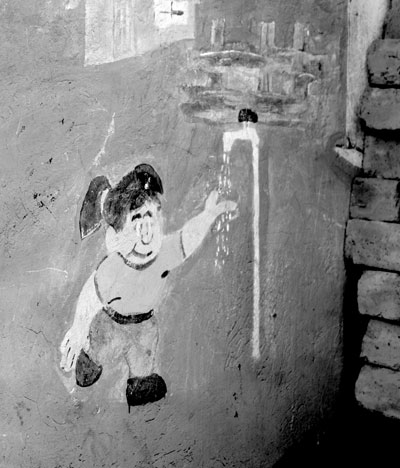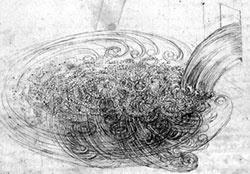Chapter 8
By Eugene F. Provenzo, Jr. and Cory A. Buxton
Water in Art, Literature & Music

Mural on wall in small town of Ecuador.
| Florida Sunshine State Standards Benchmark | |
| VA.B. 1.2.1 | The student understands that subject matter used to create unique works of art can come from personal experience, observation, imagination, and themes. |
|---|---|
| VA.B. 1.2.3 | The student knows how to identify the intentions of those creating works of art. |
| VA.C. 1.2.1 | The student understands the similarities and differences in works of art from a variety of sources. |
| SC.H. 1.2.2 | The student understands how artists have used visual languages and symbol systems through time and across cultures. |
Representations of Water in Art
Water and oxygen are the most important elements for sustaining human life. We cannot live without water. Water surrounds us. We live on a water planet. It should not be surprising, therefore, that water is often a theme found in art. Drawings by the great Renaissance painter and inventor Leonardo da Vinci give us a sense of water’s movement and dynamic quality. In Japanese culture there is perhaps no more famous image than The Breaking Wave Off Kanagawa (also called The Great Wave), by Katsushika Hokusai (1760-1849).
In Western music there are few more famous pieces than George Frideric Handel’s (1685-1759) Water Music, an orchestral suite that was written for the King of England. Sea shanties and water songs are a worldwide tradition. Water is also the subject of poetry found around the world, from the Muslim/Sufi poet Shaikh Abu-Said Abil-Kheir (967-1049) “Mansoor, that whale of the Oceans of Love” to the American poet Emily Dickinson (1830-1886) “I taste a liquor never brewed.”

The Breaking Wave Off Kanagawa. Also called The Great Wave by Katsushika Hokusai (1760-1849). Woodblock print from Hokusai’s series Thirty-six Views of Fuji. This work is widely considered the greatest of all Japanese wood prints. The original is at the Hakone Museum in Japan.
Activity: Discover Themes of Water in Art
In the following activity, students will explore representations of water in art. The activity will take them online to search for materials on the Internet.
They will be required to find a painting, an engraving, or some other graphic piece of art that represents water. Students will have to develop an argument that explains why they think a particular work represents or portrays water in a special or unique way.
Have them make a print, at least 4x6 inches, of the work. Have them accompany the print with a short statement (for younger children, a sentence; for secondary students, a paragraph) that summarizes why they have chosen the work.

Studies of Water passing Obstacles and falling (c. 1508-1509) by Leonardo da Vinci (1452-1519).
Then, using paper, pencil, colored markers, or any other convenient medium, have them create a work of their own that represents the same theme as the artwork they have chosen (in the case of the illustrations found above, this would be the movement of water).
Students should feel free to use traditional methods of drawing and painting, as well as techniques such as collage.
The works done by students can be collected together and put onto a bulletin board, or they can be scanned and put up as an exhibit on a website.
Have students review the following summary questions:
- How is water represented in different artistic traditions and different cultures?
- Are there universal themes in the representation of water in art across different cultures? If yes, what are these themes?
Consider the Following Poem
“The taste, by the American writer
Jack Keroauac (1922-1969):
The taste of rain—Why kneel?”
Exploring One Water
Look at the following clip of the celebration of Suneori Amagoi, in Tsuvugashima, Japan.
Video clip coming soon.
Suneori Amagoi celebration is a ritual for which hundreds turn out every four years to pray for rain.
Thinking about how water is represented in art gives us the opportunity to explore our personal selves and to be creative. In the following activities, students will use water to explore different artistic mediums and to create art of their own.
Extension Activities
Elementary School Students
Have students bring in at least five or six images of water from a newspaper, a magazine, or from something printed off the Internet. Have them create their own collage from the images. Encourage them to add their own drawings or words to their collages. The collages they create can be shared and talked about, as well as used for a bulletin board display.
Multimedia
Color copy the collages created by the students and use them to make a giant collage pasted down to several poster boards or a giant piece of brown wrapping paper. You can also scan the collages with the students and have them put together a slide show of the class’s work.
Middle School Students
Have students compile a collection of poems that use water as a major theme. An excellent resource is the website Poetry Chaikhana: Sacred Poetry from Around the World (http://www.poetry-chaikhana.com/Themes/Water.htm). This site includes collections of poems organized by different themes, including water. Have the students choose a poem they like and copy it electronically for inclusion in a class anthology. Have them write a paragraph introducing the poet and his or her work.
Multimedia
Have students write their own poems about water and then, using a digital recorder, have them recite their work. Create a Power Point™ presentation with the text of the poem and a “clickable” reading of it by its student creator. The materials created can be distributed as CD-ROM anthologies, or they can be posted on a website for others to see and hear.
Secondary School Students
Have students listen to classical works that focus on water such as Smetana’s “The Moldau,” Debussy’s “La Mer,” and Handel’s “Water Music.” Have them use one of these works, separately or in a group, in a medium of their choice (dance, rap, poetry, etc.) to create an artistic representation of water.
Multimedia
Sea songs and shanties that focus on water as a theme are a tradition found across many cultures. Have students research this type of music and, if they are musicians, have them perform and record examples. These can be posted by the students on YouTube or a website. A particularly helpful website for this activity is Songs of the Sea (http://www.contemplator.com/sea/index.html).
